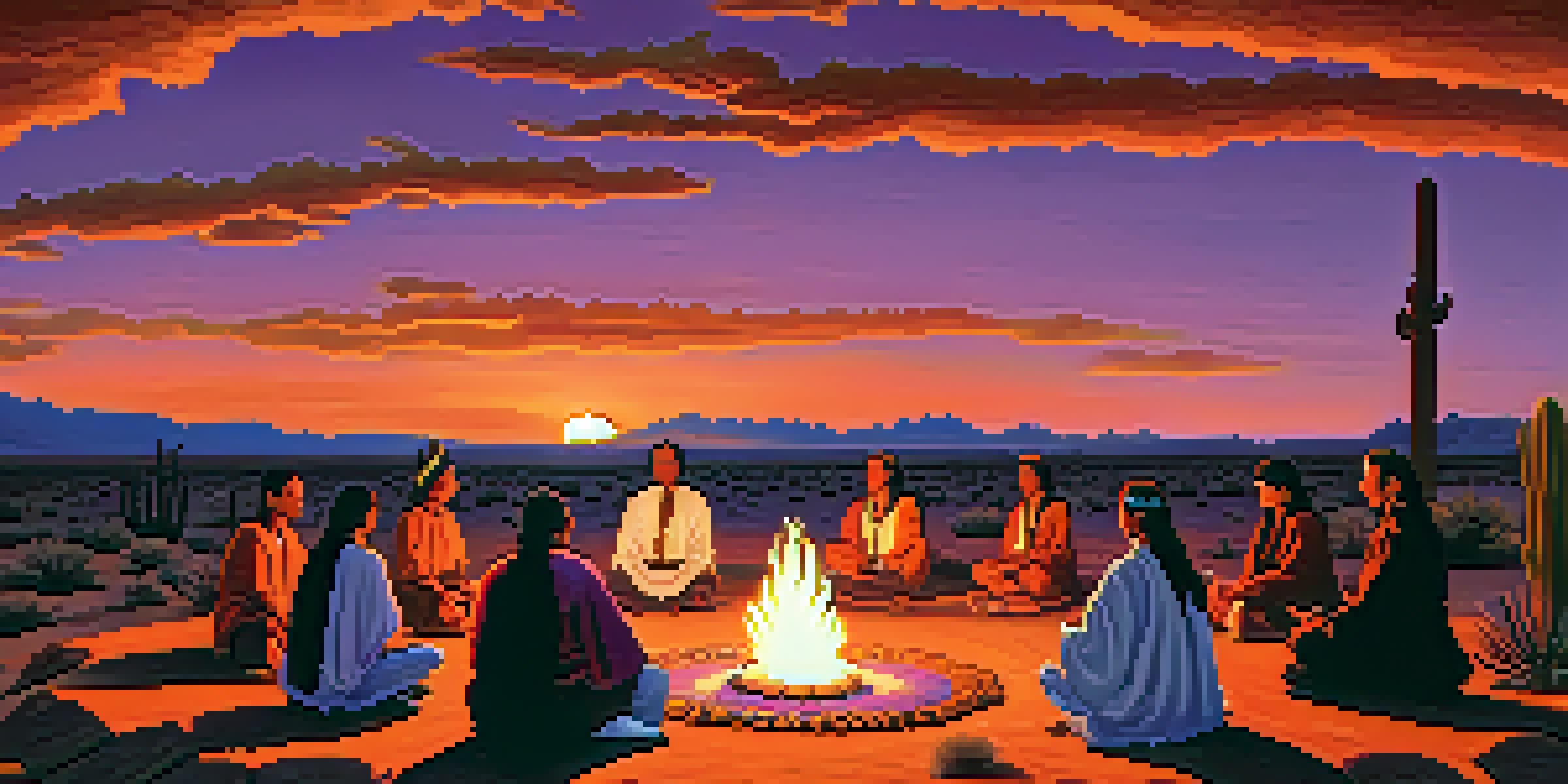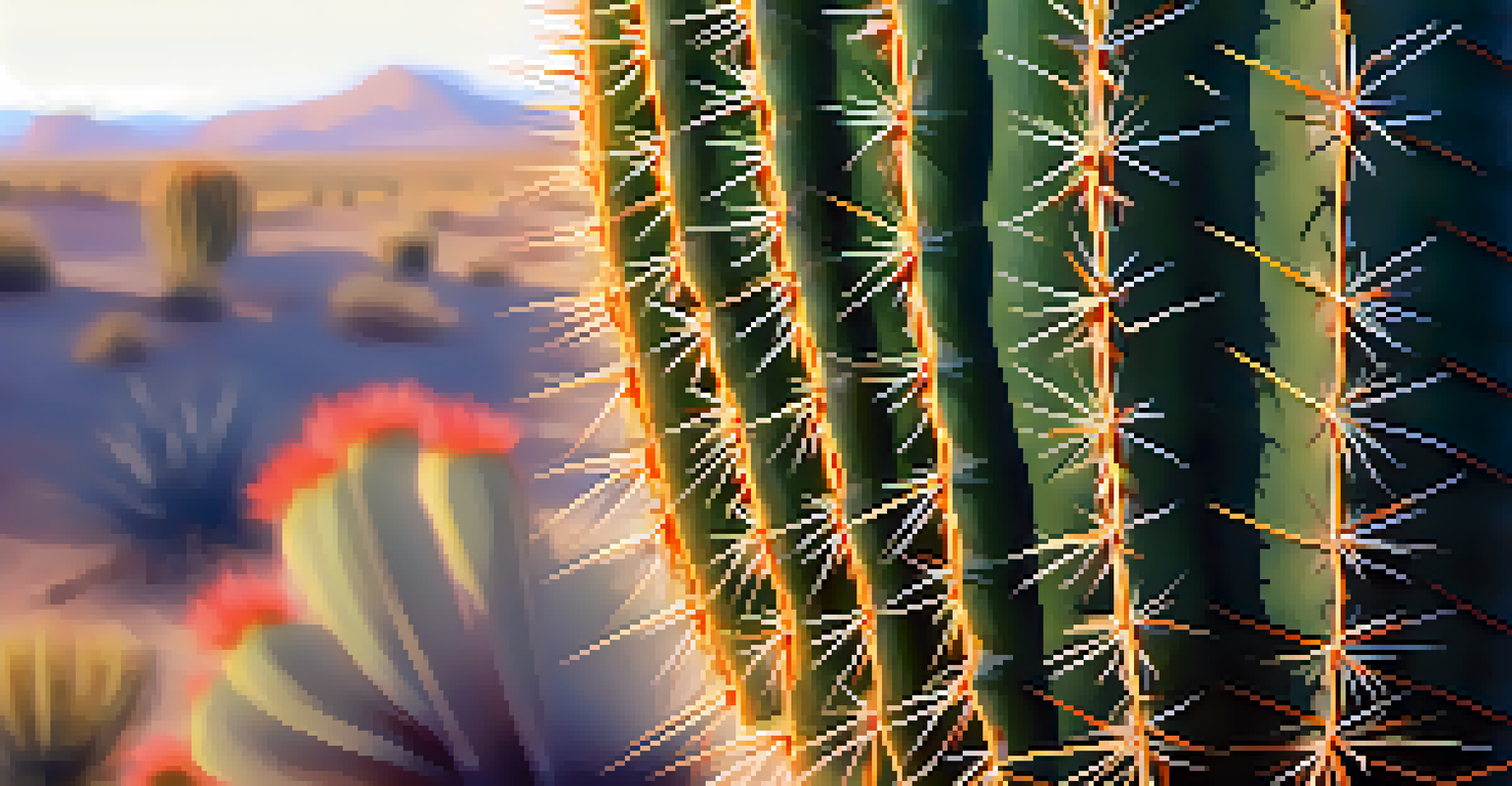The Spiritual Significance of Peyote in Indigenous Storytelling

Understanding Peyote: A Sacred Plant in Indigenous Cultures
Peyote, a small cactus native to North America, holds deep spiritual significance in many Indigenous cultures. For these communities, it's more than just a plant; it's a pivotal element in their spiritual and medicinal practices. Traditionally, peyote is used in ceremonies to facilitate healing and connect with the divine.
The plant is seen as a bridge between the physical and spiritual realms, allowing individuals to explore deeper truths about themselves and the universe.
The use of peyote dates back thousands of years, particularly among tribes in the Southwest United States and northern Mexico. Its psychoactive properties are believed to help individuals gain insights, heal emotional wounds, and foster a sense of community. This sacred plant is often consumed during rituals that emphasize introspection and spiritual connection.
In these cultures, peyote is revered not just for its effects but for the stories and teachings it embodies. The plant is seen as a bridge between the physical and spiritual realms, allowing individuals to explore deeper truths about themselves and the universe.
The Role of Storytelling in Indigenous Cultures
Storytelling is a cornerstone of Indigenous cultures, serving as a means to pass down wisdom, traditions, and values from one generation to the next. These narratives often reflect the community's relationship with the land, the cosmos, and the spiritual realm. Through storytelling, lessons are taught, and cultural identity is preserved.

In many Indigenous communities, stories are not merely entertainment; they are a vital part of spiritual education. They weave together history, morality, and spirituality, often featuring animals, ancestors, and natural elements as characters. This storytelling tradition creates a shared understanding and reinforces community bonds.
Peyote's Spiritual Significance
Peyote is revered in Indigenous cultures as a sacred plant essential for spiritual and healing practices.
When peyote is involved in these narratives, it often symbolizes transformation and enlightenment. The stories may recount personal journeys of healing and discovery, illustrating how peyote can guide individuals on their spiritual paths and connect them to their heritage.
Peyote Ceremonies: A Fusion of Ritual and Story
Peyote ceremonies are unique communal events where participants consume the cactus under the guidance of a spiritual leader. These ceremonies are rich in ritual, often incorporating singing, drumming, and storytelling, creating a holistic experience that engages both the body and spirit. The narrative unfolds as participants share their experiences and insights during the journey.
Peyote is not just a plant, but a pivotal character in many Indigenous narratives.
The stories told during these ceremonies often reflect the collective experiences of the community, serving as both a personal and shared journey. Participants recount their visions and lessons learned, creating a tapestry of individual and communal wisdom. This fusion of ritual and storytelling reinforces the spiritual significance of peyote.
Moreover, the sacred space created during these ceremonies allows for deep emotional and spiritual healing. The narratives shared can offer comfort, guidance, and a sense of belonging, emphasizing the importance of community during transformative experiences.
The Symbolism of Peyote in Indigenous Narratives
In Indigenous storytelling, peyote often symbolizes knowledge, transformation, and spiritual awakening. It is viewed as a teacher that reveals deeper truths about existence and the self. This symbolism is crucial in narratives that explore personal development, healing, and the quest for understanding.
Characters in these stories frequently undergo profound changes after engaging with peyote, reflecting the transformative power of the plant. The journeys they embark on can mirror the struggles and triumphs faced by individuals in real life, providing relatable lessons for listeners. This makes peyote not just a plant, but a pivotal character in many Indigenous narratives.
The Importance of Storytelling
Storytelling serves as a vital means to pass down wisdom and cultural identity within Indigenous communities.
Through these stories, peyote illustrates the interconnectedness of all beings and the importance of respecting nature. The narratives often emphasize stewardship of the earth and highlight the spiritual lessons that arise from a deep connection to the environment.
Challenges and Misunderstandings Surrounding Peyote Use
Despite its rich history and cultural significance, peyote has faced challenges, particularly with misconceptions about its use. Many people outside Indigenous communities may view peyote as merely a hallucinogenic substance, overlooking its sacred role in spiritual practices. This misunderstanding can lead to cultural appropriation and disrespect towards Indigenous traditions.
The legal status of peyote also presents challenges for Indigenous communities. While it is protected for ceremonial use, the increasing interest in psychedelics can complicate its availability and the traditional practices surrounding it. This situation underscores the need for respectful dialogue and understanding of Indigenous rights and customs.
Educating others about the spiritual significance of peyote is crucial in preserving its place in Indigenous cultures. By sharing the stories and teachings associated with peyote, we can foster greater respect and appreciation for these traditions, ensuring they are honored and protected.
Modern Interpretations of Peyote in Storytelling
In contemporary times, the narrative surrounding peyote continues to evolve. Many Indigenous storytellers are finding new ways to express the significance of peyote in their lives and communities, often blending traditional stories with modern perspectives. This fusion helps to keep the teachings relevant for younger generations.
As society becomes more interested in spirituality and alternative healing, the stories surrounding peyote are gaining attention beyond Indigenous circles. This can lead to a broader appreciation for the cultural context of peyote, but it also raises concerns about cultural appropriation and the commercialization of sacred practices.
Challenges to Peyote Practices
Misunderstandings and legal challenges threaten the traditional use and cultural significance of peyote among Indigenous peoples.
Through modern storytelling, Indigenous voices are reclaiming their narratives and emphasizing the importance of respecting cultural heritage. By sharing their experiences with peyote, they continue to educate others about its profound significance, ensuring that its legacy endures.
The Future of Peyote in Indigenous Storytelling
Looking ahead, the future of peyote in Indigenous storytelling remains both hopeful and challenging. As Indigenous communities navigate contemporary issues, the role of peyote may evolve, but its spiritual significance will likely endure. This adaptability is a testament to the resilience of these cultures and their stories.
Efforts to preserve traditional narratives and practices surrounding peyote are crucial in maintaining cultural identity. Programs that promote Indigenous storytelling and education can empower younger generations to carry these teachings forward, ensuring that the wisdom of their ancestors lives on.

Ultimately, the stories surrounding peyote will continue to serve as a powerful reminder of the interconnectedness of all life and the importance of spiritual growth. By honoring these narratives, we can contribute to a deeper understanding of Indigenous cultures and the sacredness of peyote.